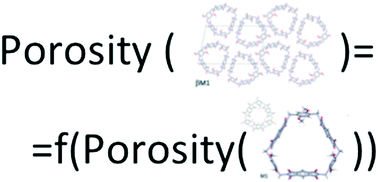Toward crystalline porosity estimators for porous molecules†
Abstract
Crystalline porous solids based on molecules with intrinsic porosities are a diverse group of materials that have been investigated in the context of adsorption-based separations and other applications. Novel computational approaches are being developed to identify structures with desired properties by sieving through large sets of candidates. Recently, both in silico synthesis of new porous molecular species and identification of alike in large molecular databases have become possible. However, assessing the porosity of the corresponding crystalline materials has been based on performing crystal structure prediction (CSP), followed by the characterization of the porosity of the resulting phases. CSP has a significant computational cost, which seriously limits the possibility of high-throughput computational screening applications. Herein, we present an avenue to circumvent the need for CSP for every investigated molecular structure by introduction of molecular-based crystalline material porosity estimators. In particular, our analysis of previously-reported crystalline porous materials involving porous molecules uncovered the correlations between the molecular porosity descriptors and the porosity descriptors of the corresponding crystalline phases. We exploit these correlations by building random forest classifiers and regressors to estimate the material porosity based on the structure of its porous molecular building block.

- This article is part of the themed collection: The Cambridge Structural Database - A wealth of knowledge gained from a million structures


 Please wait while we load your content...
Please wait while we load your content...